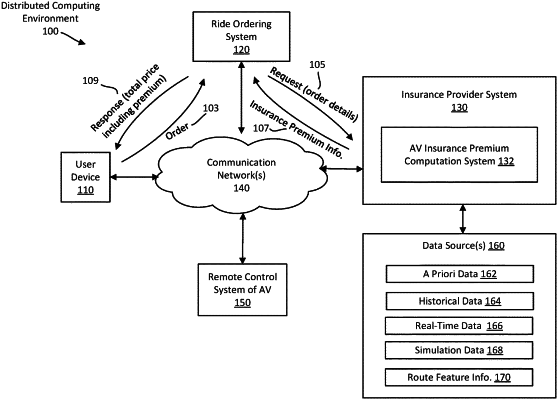| CPC G06Q 40/08 (2013.01) [G01C 21/3453 (2013.01); G01C 21/3691 (2013.01); G05D 1/0088 (2013.01)] | 20 Claims |

|
1. A method comprising:
receiving, by a computer system, a request to provide an autonomous vehicle (AV) ride being booked by a user, wherein the request includes information identifying a start point and an end point for the AV ride, and information identifying an AV to be used for the ride;
determining, by the computer system, at least one route from the start point to the end point, the at least one route including a first route;
accessing, by the computer system, route data including attributes of the first route;
accessing, by the computer system, vehicle data including attributes of the AV, wherein at least some of the attributes included in the route data or the vehicle data are determined at a time associated with the AV ride;
generating, by the computer system and using a first pre-trained risk model, a first risk value for the first route, wherein the first pre-trained risk model predicts the first risk value based on the route data, and wherein the first risk value represents a likelihood, given the route data, of occurrence of an incident during the AV ride, wherein an incident is an unsafe condition or disengagement of autonomous control, wherein generating the first risk value includes calculating a pickup and drop-off complexity index (PDCI) for the route, the PDCI based on attributes associated with the start point and attributes associated with the end point, wherein the PDCI represents a degree of difficulty in navigating around the start point and the end point, wherein the first risk value is based at least in part on the PDCI;
generating, by the computer system and using a second pre-trained risk model, a second risk value for the AV, wherein the second pre-trained risk model predicts the second risk value based on the vehicle data, and wherein the second risk value represents a likelihood, given the vehicle data, of occurrence of an incident during the AV ride;
generating, by the computer system and using a first pre-trained pricing model, a first loss value for the first route, wherein the first pre-trained pricing model predicts the first loss value based on the route data, and wherein the first loss value represents a loss associated with the route data;
generating, by the computer system and using a second pre-trained pricing model, a second loss value for the AV, wherein the second pre-trained pricing model predicts the second loss value based on the vehicle data, and wherein the second loss value represents a loss associated with the vehicle data;
selecting, by the computer system, a route for use during the AV ride from the at least one route based at least in part on the first risk value, the first loss value, the second risk value, and the second loss value; and
communicating, by the computer system, the selected actual route to a controller system of the AV;
obtaining, by the controller system, sensor data from a plurality of sensors, wherein the sensor data provides a representation of operation of the AV in an environment;
generating, by the controller system, an internal map based on the sensor data, wherein the internal map comprises a three-dimensional representation of the environment around the AV, information on a current state of the AV, and information about the environment;
generating, by the controller system, a plan of action for the AV that identifies a trajectory or path to be traversed by the AV based on the selected actual route and the internal map, wherein the plan comprises one or more planned actions or operations to be performed by the AV to travel from point A to point B along the trajectory or path; and
controlling, by the controller system, one or more vehicle systems of the AV to cause the planned actions or operations to be performed by the AV while traveling from the point A to the point B along the trajectory or path.
|